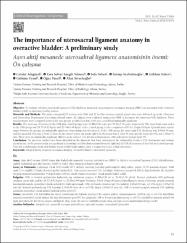| dc.contributor.author | Adıgüzel, Cevdet | |
| dc.contributor.author | Yılmaz, Esra Selver Saygılı | |
| dc.contributor.author | Arlıer, Sefa | |
| dc.contributor.author | Seyfettinoğlu, Sevtap | |
| dc.contributor.author | Şoker, Gökhan | |
| dc.contributor.author | Uysal, Gülsüm | |
| dc.contributor.author | Sivaslıoğlu, Akın | |
| dc.date.accessioned | 2020-11-20T14:50:21Z | |
| dc.date.available | 2020-11-20T14:50:21Z | |
| dc.date.issued | 2018 | |
| dc.identifier.issn | 2149-9322 | |
| dc.identifier.issn | 2149-9330 | |
| dc.identifier.uri | https://doi.org/10.4274/tjod.73669 | |
| dc.identifier.uri | https://app.trdizin.gov.tr//makale/TXpBM01qZzFOUT09 | |
| dc.identifier.uri | https://hdl.handle.net/20.500.12809/1527 | |
| dc.description | WOS: 000429369600014 | en_US |
| dc.description | PubMed ID: 29662719 | en_US |
| dc.description.abstract | Objective: To evaluate whether uterosacral ligament (USL) thickness measured using magnetic resonance imaging (MRI) was associated with overactive bladder (OAB) in otherwise healthy women. Materials and Methods: The study comprised 27 women with OAB and 27 healthy women (control group) who were followed up at the Obstetrics and Gynecology Department of a tertiary referral center. All subjects were evaluated using pelvic MRI to determine the transverse USL thickness. These measurements were compared between the two groups. p values less than 0.05 were considered statistically significant. Results: The mean age of women in the OAB and control groups were 43.88 +/- 9.36 years and 39.92 +/- 5.36 years, respectively. The mean body mass index in the OAB group was 29.77 +/- 4.82 kg/m(2) and 27.49 +/- 3.44 kg/m(2) in the control group. In the comparison of Pelvic Organ Prolapse Quantification system stages between the groups, no statistically significant relationship was determined. In the OAB group, the mean right USL thickness was 2.04 +/- 0.34 mm, and the mean left USL was 2.04 +/- 0.52 mm. In the control group, the mean right USL thickness was 2.17 +/- 0.47 mm, and the mean left USL was 2.09 +/- 0.51 mm. There were no statistically significant differences in terms of USL thickness between the OAB and control groups (p> 0.05). Conclusion: No previous studies have been identified in the literature that have investigated the relationship between USL thicknesses and urinary incontinence. In the present study, no significant relationship could be demonstrated between right and left USL thicknesses of the OAB and control groups. This was a preliminary study, and further research with larger sample sizes is required to reach a final conclusion. | en_US |
| dc.description.abstract | Amaç: Aşırı aktif mesane (AAM) tanısı alan kadınlarda manyetik rezonans görüntüleme (MRG) ile ölçülen uterosakral ligament (USL) kalınlıklarının, sağlıklı kadınlarda aşırı aktif mesane (OAB) ile ilişkili olup olmadığını değerlendirmek.
Gereç ve Yöntemler: Çalışmaya, Ocak 2013-Aralık 2015 tarihleri arasında jinekoloji polikliniğinde takip edilen, yaşları 21-55 arasında değişen, AAM tanılı 27 ve sağlıklı 27 kadın (kontrol grubu) dahil edildi. Tüm olgular, transvers USL kalınlığını belirlemek için pelvik MR ile değerlendirildi. Bu ölçümler iki grup arasında karşılaştırıldı. P değerlerinin 0,05’ten küçük olması istatistiksel olarak anlamlı kabul edildi.
Bulgular: OAB ve kontrol grubundaki kadınların yaş ortalaması sırasıyla 43,88±9,36 yıl ve 39,92±5,36 yıl idi. Kontrol grubunda OAB grubunda ortalama vücut kitle indeksi 29,77±4,82 kg/m2 ve 27,49±3,44 kg/m2 bulundu. Pelvik Organ Prolapsus Kantifikasyon sistem evrelerinin gruplar arasında karşılaştırılmasında istatistiksel olarak anlamlı bir ilişki saptanmadı. OAB grubunda ortalama sağ USL kalınlığı 2,04±0,34 mm, sol USL değeri 2,04±0,52
mm idi. Kontrol grubunda sağ USL kalınlığı 2,17±0,47 mm idi ve sol USL değeri 2,09±0,51 mm idi. OAB ve kontrol grupları arasında USL kalınlığı açısından istatistiksel olarak anlamlı farklılık yoktu (p>0,05).
Sonuç: Literatürde USL kalınlıklarının üriner inkontinans ile ilişkisini inceleyen bir çalışma yoktur. Araştırmamızda, AAM ile sağ ve sol USL kalınlıkları arasında istatistiksel olarak anlamlı bir ilişki bulunmadı (p>0,05). Bu çalışmada OAB ve kontrol gruplarının sağ ve sol USL kalınlıkları arasında anlamlı bir ilişki gösterilemedi. Bu bir ön çalışma niteliğinde olup, kesin bir sonuca varılabilmesi için daha çok olgu içeren araştırmalara ihtiyaç vardır. | |
| dc.item-language.iso | eng | en_US |
| dc.publisher | Galenos Yayincilik | en_US |
| dc.item-rights | info:eu-repo/semantics/openAccess | en_US |
| dc.subject | Integral Theory | en_US |
| dc.subject | Magnetic Resonance Imaging | en_US |
| dc.subject | Overactive Bladder | en_US |
| dc.subject | Uterosacral Ligaments | en_US |
| dc.title | The importance of uterosacral ligament anatomy in overactive bladder: A preliminary study | en_US |
| dc.item-title.alternative | Aşırı aktif mesanede uterosakral ligament anatomisinin önemi: Ön çalışma | |
| dc.item-type | article | en_US |
| dc.contributor.department | MÜ, Tıp Fakültesi, Cerrahi Tıp Bilimleri Bölümü | en_US |
| dc.contributor.institutionauthor | Sivaslıoğlu, Akın | |
| dc.identifier.doi | 10.4274/tjod.73669 | |
| dc.identifier.volume | 15 | en_US |
| dc.identifier.issue | 1 | en_US |
| dc.identifier.startpage | 65 | en_US |
| dc.identifier.endpage | 69 | en_US |
| dc.relation.journal | Turkish Journal of Obstetrics and Gynecology | en_US |
| dc.relation.publicationcategory | Makale - Uluslararası Hakemli Dergi - Kurum Öğretim Elemanı | en_US |


















